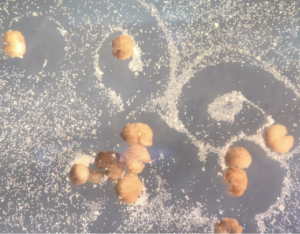The dangers of microplastics.
Microplastics live at the summit of Mount Everest and even in the Mariana Trench, covering our Earth (10). Since plastic cannot biodegrade, it breaks down into microparticles, fragments of plastic less than 5 mm in length; they can be smaller than a grain of sand, traveling amongst dust in the atmosphere (5). These microscopic plastics are making their way all around the globe, sneaking their way into food and water sources. Marine organisms and humans consume these toxic particles, which causes harmful side effects. Microplastics are invading the enviroemnt and adversely affecting life
Microplastics are dangerous predators to the environment and humans. When consumed, microplastics can reduce organisms’ nutrient intake from food, causing oxidative damage and abnormalities in behavior (7). Microplastics also threaten population growth. They cause issues with fertility, including the reduction of sperm count and motility, and egg ovulation. Furthermore, nano-scale microplastics can penetrate biological barriers and amass in tissue, which affects lipid metabolism and causes other complications on molecular levels.
Although humanity is battling the general production of plastics and pollution, we fail to consider the minute polluters. The clothing industry is one example. Nylon, acrylic, and polyester, all partially constructed from plastic, make up 60% of the materials used in clothing production. A typical 50-minute load of laundry will produce around 700,000 microplastic fibers; the simple act of washing your clothes can have long-lasting impacts (6). It can take between 450 and 1,000 years for microplastics to degrade.
Microplastics are reaching the farthest corners of our world. Since plastic’s mass production began, humankind has produced over eight billion metric tons of plastic. 80% of the plastic produced in the past 60 years has amassed in landfills or remains strewn about the earth (1). Plastic will slowly break down into microplastics, but they never will truly leave our planet. According to National Geographic, “some microplastics are so tiny they are part of the dust that blows around the planet, high in the atmosphere.” In 2014, researchers estimated that between 5.25 and 50 trillion pieces of microplastic are present on our earth (3). National Geographic reports a daily rate of 365 microplastic particles per square meter raining from the Pyrenees Mountains in southern France.

Microplastics are most abundant in our oceans. There are around 24.5 trillion pieces of microplastic in the oceans of the southern hemisphere, which is equivalent to 300 billion plastic water bottles. For example, Blue Mussels are the microplastic sink of our oceans. Scientists found that the absorption efficiency of Blue Mussels not exposed to microplastics was 20% greater than Blue Mussels exposed to microplastics (11). The consequences of these numbers are present in the marine life of these oceans (7). With sources of microplastics like The Great Pacific Garbage Patch, a mass of garbage floating between California and Hawai’i that spans 1.6 million kilometers (8), plastic will continue to pollute our oceans until humanity decides to take action.
Fish are not the only organisms suffering the consequences of the prevalence of microplastics. Humans consume microplastics through our water and food. Microplastics can cause inflammatory lesions, metabolic disturbances, neurotoxicity, and an increased risk for cancer (9).
Humanity needs to focus on regulating the plastic industry and reducing plastic intake to decrease the effects of this microplastic crisis.
Bibliography:
- Haslam, Faye. “The Big Problem of Microplastics.” The University of Nottingham. Accessed January 22, 2022. https://www.nottingham.ac.uk/connectonline/research/2018/the-big-problem-of-microplastics.aspx.
- Cox, Kieran D. 2022, January 22. “Human Consumption of Microplastics.” ACS Publications. https://pubs.acs.org/doi/10.1021/acs.est.9b01517.
- Parker, Laura. 2021, May 3, “Microplastics Have Moved into Virtually Every Crevice on Earth.” Science. National Geographic https://www.nationalgeographic.com/science/article/microplastics-in-virtually-every-crevice-on-earth?loggedin=true.
- University, Kyushu. 2021, October 27. “Twenty-Four Trillion Pieces of Microplastics in the Ocean and Counting.” ScienceDaily. ScienceDaily, https://www.sciencedaily.com/releases/2021/10/211027122120.htm#:~:text=The%20team%20estimates%20there%20are,500%2Dml%20plastic%20water%20bottles.
- Leahy, Stephen. 2021, May 3 “Microplastics Are Raining down from the Sky, Even in the Mountains.” Environment. National Geographic, https://www.nationalgeographic.com/environment/article/microplastics-pollution-falls-from-air-even-mountains.
- &64;CondorFerries. “100+ Plastic in the Ocean Statistics & Facts (2020-2021).” Condor Ferries. Accessed January 22, 2022. https://www.condorferries.co.uk/plastic-in-the-ocean-statistics.
- Li1, You, Yixin Sun1, Jinzhen Li1, Ruikai Tang1, Yifa Miu1, and Xiaoyi Ma1. 2021, January 1. “IOPscience.” IOP Conference Series: Earth and Environmental Science. IOP Publishing, https://iopscience.iop.org/article/10.1088/1755-1315/631/1/012006.
- Magazine, Smithsonian. 2021, October 19.“This New Installation Pulled 20,000 Pounds of Plastic from the Great Pacific Garbage Patch.” Smithsonian.com. Smithsonian Institution. https://www.smithsonianmag.com/smart-news/this-new-installation-just-pulled-20000-pounds-of-plastic-from-the-great-pacific-garbage-patch-180978895/.
- Rahman, Arifur, Atanu Sarkar, Om Prakash Yadav, Gopal Achari, and Jaroslav Slobodnik. 2020, December 3. “Potential Human Health Risks Due to Environmental Exposure to Nano- and Microplastics and Knowledge Gaps: A Scoping Review.” Science of The Total Environment. Elsevier. https://www.sciencedirect.com/science/article/abs/pii/S0048969720374039#:~:text=Microplastics%20exposure%20can%20cause%20toxicity,increased%20cancer%20risk%20in%20humans.
- Gibbens, Sarah. 2021, May 3. “Microplastic Permeates Mariana Trench and Other Deep Sea Points.” Environment. National Geographic. https://www.nationalgeographic.com/environment/article/microplastic-pollution-is-found-in-deep-sea#:~:text=Microplastics%20found%20to%20permeate%20the,pieces%2C%20according%20to%20new%20research.&text=In%20the%20trench%27s%20most%20polluted,of%20microplastic%20in%20one%20liter.
- Rochman, C. (n.d.). EFFECTS OF MICROPLASTICS ON FISH AND INVERTEBRATES. Sixth International Marine Debris Conference. Retrieved February 4, 2022, from https://internationalmarinedebrisconference.org/index.php/effects-of-microplastics-on-fish-and-invertebrates/
- https://www.google.com/url?sa=i&url=https%3A%2F%2Fwww.theguardian.com%2Fenvironment%2F2021%2Ffeb%2F18%2Fmicroplastics-oceans-environment-science&psig=AOvVaw2nR_Mf1DWmdmrCY3Ge0JyE&ust=1642969227508000&source=images&cd=vfe&ved=0CAsQjRxqFwoTCJCE6sCXxvUCFQAAAAAdAAAAABAD







Comments are closed.